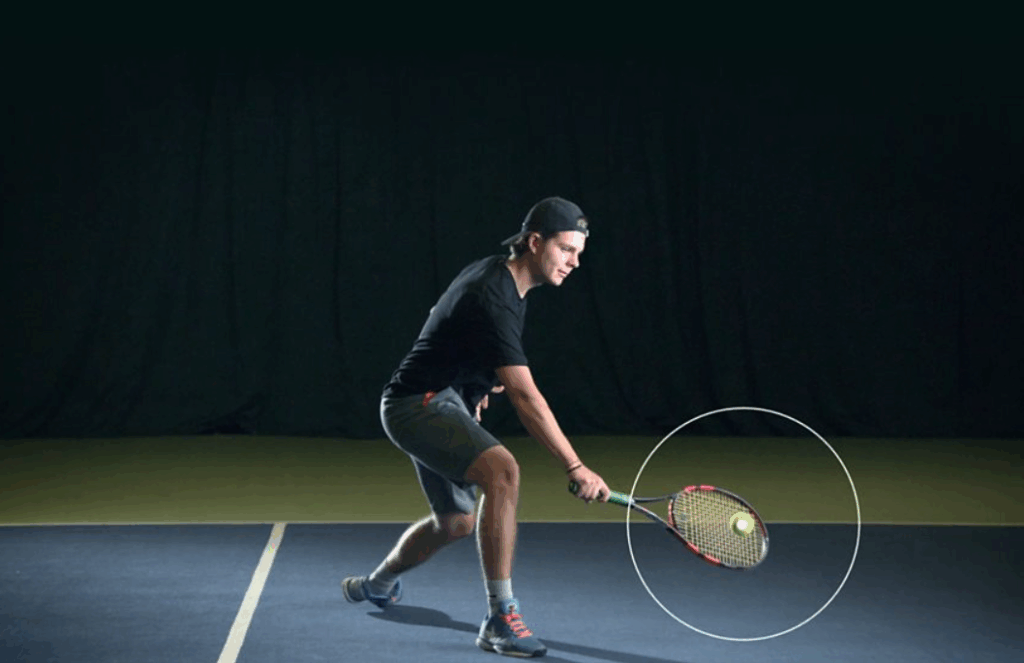Your tennis journey begins with mastering the forehand stroke, backhand, serve, forehand volley, backhand volley, and overhead smash. Start with the forehand, your most natural groundstroke, before progressing to the two-handed or one-handed backhand.
The serve becomes your game-starter, while volleys and smashes enhance your net play. As you build this foundation, each stroke opens new possibilities for your court strategy and success.
The Forehand Stroke
The forehand is often the most natural and strongest groundstroke a player can develop, and is your starting point to tennis success. To execute it effectively, start with a proper grip. Wrap your dominant hand around the racquet handle like you’re shaking hands with it.
Place yourself sideways towards the net, your feet shoulder-width apart, and your knees slightly bent. Before hitting, turn your shoulders and bring the racquet back in a controlled motion.
Focus on the ball when you step forward with your front foot. When making contact, accelerate through the ball with your racquet face angled slightly upward.
Complete the stroke by following through across your body, letting your momentum carry the racquet over your opposite shoulder.

The Backhand Stroke
The backhand stroke offers two options for players. It can be the one-handed technique or the more modern two-handed approach. All styles have their merits. Choose one based on comfort and playing style.
Focus on hip rotation and shoulder turn when you stroke the backhand. Point your non-dominant shoulder toward your target first, then rotate through with a locked wrist. Keep your racquet head level during the motion.
A backhand requires timing. Take an early backswing, bend your knees slightly, and then shift your weight forward when you touch the ball. Follow through with your target to ensure clean ball striking.
The Serve
Serving stands as the most critical shot in tennis, putting you in control of starting each point. Learn grip, toss, and swing coordination. Start by holding your racket with a continental grip, which allows for maximum power and spin control.
Your ball toss should be consistent and reach a height that lets you fully extend your hitting arm. As you toss, bend your knees and coil your body for the serve motion. Your swing should flow smoothly from the trophy position, racket behind your head, through contact, and follow-through. Keep moving forward and rotating your shoulders to create power.

The Volley and Overhead Smash
Volleys and overhead smashes are essential weapons when playing at the net. Position yourself two feet behind the net for a volley and hold your racquet in front of you firmly. Punch the ball rather than swing it in short, compact movements.
The timing of an overhead smash is critical. As you position yourself underneath it, watch the ball fly like you would on a serve. Point your non-racket hand at the ball as you swing backward, then swing your racket arm up and forward explosively.
Keep your drive high for maximum power and control. You should practice these shots often to gain confidence on the court.
Specialty Strokes: The Drop Shot
To perform this delicate stroke, you’ll need precise control and proper stroke mechanics. Position your racquet face slightly open, and use a shorter backswing than your standard groundstrokes.
The key to an effective drop shot lies in your ability to disguise it. Make your setup appear similar to a regular forehand or backhand, then reduce your swing speed at the last moment. Contact the ball with a gentle brushing motion, adding slight backspin to help it die quickly after bouncing.
Practice this shot when your opponent is positioned deep in the court, making it harder for them to reach the softly dropped ball.

Frequently Asked Questions
What Type of Tennis Shoes Are Best for Beginners?
Have lightweight tennis shoes with good ankle support, cushioning, and non-marking soles. Look for models from brands like Nike, Adidas, or Asics that offer stability and comfort for your playing style.
How Long Does It Take to Master All Basic Tennis Strokes?
You’ll need 6-12 months of consistent practice to master all basic tennis strokes. It depends on your natural ability, practice frequency, and quality of instruction. Don’t rush. Focus on proper technique first.
Should Beginners Use Specialized Tennis Strings for Better Performance?
You don’t need specialized strings as a beginner. Start with standard, medium-tension strings that offer good durability and control. Focus on developing proper technique first before investing in advanced equipment.
What’s the Ideal Tennis Racket Weight and Size for New Players?
Have a racket between 260-280 grams with a head size of 100-105 square inches. This lighter weight gives you better control, while the larger head helps you hit the sweet spot more easily.
When Is the Best Time to Start Playing Competitive Tennis Matches?
You’re ready for competitive matches after you’ve mastered basic strokes and can maintain consistent rallies. Start with friendly matches at 6-8 months of training, then progress to local tournaments when you’re confident.





